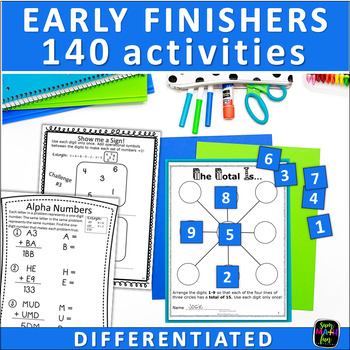140 Early Finishers Math Brain Teasers | Fast Finishers Gifted Activities Bundle
- Zip
- Google Apps™
- Internet Activities

What educators are saying
Products in this Bundle (5)
Bonus
Description
Solve all of your fast-finisher problems with these activities! This bundle of 140 enrichment activities is the answer to I'm done! Now what?!
We call these early finishers or fast finishers activities. But really, these math brain teasers can be used with ALL of your students. They are ideal for morning work to get your kids "mathing".
No matter how good we are at differentiating, we still have early finishers. We know that giving them more of the same work is not the answer. They need to have math activities that extend and challenge their thinking. These brain teasers do that!
There are 140 activities (including 10 newly added!) perfectly aligned to the Common Core Mathematical Practices and Texas TEKS Process Standards! Each challenge was carefully crafted with problem-solving in mind.
Modalities vary within the brain teasers, so students stay highly engaged. With this resource, students will have rigorous work to do once they have completed assignments! You can make the print version into an early finisher booklet. Give it to your students or add it to your early finishers bin and tell them when they complete their assignment, they can work on it. Assign the digital version through Google Classroom. Easy!
The digital activities are completely separate. They are in color with movable pieces and interactive text boxes to amplify the fun factor. These math brain teaser challenges are highly engaging and motivating!
⭐ ALL Early Finisher PACKS are completely digital with interactive parts, not just overlays. Tons of fun for interactive math centers! You can have ALL of your students working on the same activities, even if some students need paper and pencil while others need interactive digital work at centers. So very helpful!!
✹ The term "Smarty Pants" is not used in any student material.
►VARIETY OF USES FOR DIFFERENTIATION
These could be used in a variety of ways - class-wide, individual, homework, assessment, guided math groups, or intervention. You may choose to utilize the early finisher resources or assign them through Google Classroom, they will serve as meaningful work for students to complete when they are finished and are waiting for the rest of the class.
You will no longer spend hours looking for something to keep your early finishers engaged and learning, and you won't hear, "I'm finished; what do I do now?" anymore!
Use these math brain teasers for early finishers, gifted students, morning work, math warm-ups, math centers, or collaborative work.
►TARGETED MATHEMATICAL THINKING. NO FLUFF. RIGOROUS AND FUN!
These will have your third, fourth, and fifth graders thinking, reasoning, and using math vocabulary, order of operations, mental math, and number sense!
This packet may also work well for some 6th graders. Please see the preview!
Prevent off-task behavior by keeping those eager minds engaged, motivated, and challenged. Promote mathematical thinking and reasoning. Each brain teaser is also a springboard for great mathematical classroom conversations!
Parents love seeing these challenges come home for homework, too!
►VARIETY OF USES FOR INSTRUCTION
1. Intervention - For students who need that extra boost, this is a great opportunity to teach and practice problem-solving and many other math skills. It is a wonderful way to build mathematical confidence in students, too!
2. Early Finishers – You can use these early finisher brain teasers as a packet for students to work on independently until everyone is done. Math for Smarty Pants contains meaningful, rigorous, engaging activities that assure students are working on important skills instead of busy work.
3. Homework or Independent Work During Math Centers – Students should be able to complete these activities independently with little or no instruction using problem-solving skills and mental math.
5. Guided Math – Especially if you have limited time, these activities are perfect for guided math groups. You can focus on a problem-solving strategy, such as guessing and checking, using logical reasoning, working backward, and looking for patterns.
❤️ Why you’ll L-O-V-E this:
- "Awesome for centers and extra time fillers. Really made my higher kiddos think." –Megan
- "I have these in my early finishers bins, and they have been a big hit! My kids think they are fun, and I love that they challenge them to think outside the box!" –Alexis
- "Great resource for the "What do I do now?" moments. –TpT Buyer
- "A wonderful daily challenge to begin our summer Math session - exactly what I was looking for." –Penny
- "These have been great to have on hand for my early finishers!" –Ramblings from Rachel
- "This has been an awesome supplement for my students! Challenging, yet attainable." -Coal City Intermediate School F.
✋ Want to know more about what's included? Click on the links below to view the individual previews for each resource!
✅ Early Finishers Pack #1 || Distance Learning || Printables & Google Slides: Answer Key Included
✅ Early Finishers Pack #2 || Distance Learning || Printables & Google Slides: Answer Key Included
✅ Early Finishers and Gifted: Math Challenges #3:
Answer Key Included
✅ Place Value Number Sense Task Cards:
These Tasks are Open-Ended. An answer key is not provided since there are many possible answers for each challenge.
⭐Looking for more fun math activities to keep your students engaged and challenged? Check out these popular resources!
Related Products
◼️ Word Problems Multiple Operations - Bundled!
◼️ Equivalent Fractions Task Cards Hands-On Editable
◼️ Multi-Step Word Problem Task Cards 4th Grade
◼️ Done! Now What? Fast Finishers Challenges Bundled!
++++++++++++++++++++++++++++++++++++++++++++++++++++++++++++++
If you would like to get updates on NEW and CURRENT resources . . .
►SIGN UP to receive weekly email freebies!
►FOLLOW me on Teachers Pay Teachers!
++++++++++++++++++++++++++++++++++++++++++++++++++++++++++++++
Have fun Mathing!
-Leah





